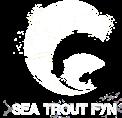SEA TROUT FYN

Issue #2021 - English

A Teenage life, spent fishing
EVERYONE IS in the SAME BOAT


Issue #2021 - English

A Teenage life, spent fishing
EVERYONE IS in the SAME BOAT
Your platform for chasing sea trout on Fyn, Ærø and Langeland. Here, you can find everything you need in your quest for sea trout – apart from the salt water!
Check out the interactive map of the 1,100 kilometres of sea trout coastline. For the first time, EVERYTHING you need has been brought together on one sea trout map. There are 117 fishing spots with satellite photos, topographical maps, descriptions of fishing spots, seasonal recommendations, conservation zones, special rules, etc. – all right at your fingertips whenever you need it!

You can also:
» Find accommodation at a certified anglers’ establishment.
» Book the island’s best sea trout angler as your own guide.
» Watch a video about fishing for sea trout.

»
» Follow our work to promote Fyn’s sea-trout stocks.


»
» Read news from the coasts, the fishing guides and partners.
»
» Gain new knowledge about sea trout and practical fishing.
»
» See conservation zone information and fishing rules for Fyn’s coastlines.

been restored to its natural level, rocks for concealment and gravel for spawning have been laid and it is truly a pleasure to see in its natural state. This has been great news for nature, “Aarslevians” and the sea trout who swim in Vindinge Å. We are still working hard in Funen’s rivers to ensure that sea trout are given even better spawning conditions.
2020 has been a strange year in many ways, and one in which almost nothing has been “business as usual”. One of its consequences has been that many people have become aware of nature-related experiences and have taken up fishing as a hobby. Sea trout fishing is one of the many natural experiences that have not changed, and this year has once again seen excellent fishing on Funen’s coasts. There have been plenty of great sea trout catches all over Funen and the archipelago, which is one thing we can’t really complain about, when all’s said and done.
Foreign sea-trout fishing enthusiasts have, however, not had the same opportunities to visit Funen’s coastline in the numbers that usually come. Normally, during the spring and autumn, you are just as likely to encounter a German, a Dutchman or someone else who isn’t Danish as you are to meet an actual Dane as you stand in your waders holding a fishing rod. This was not the case in 2020, but let’s hope that our international guests will be able to come and visit us to go fishing on the coasts of Funen during the year ahead. They are

welcome guests who take good care of our natural environment and our fish, and they help to “grease the wheels” during the off season when Funen is not usually a destination for very many tourists. Funen has over 1,100 kilometres of coastline and thus plenty of room for local and foreign sports fishermen alike, just as always.
As in many other years, 2020 has seen our involvement in several successful rivers and streams projects, which Seatrout Fynn has helped to finance. The old reservoir has finally been removed at the old paper mill in Dalum beside Odense Å river. Its absence means that sea trout now have unhindered passage to their spawning grounds and smolt will be able to swim freely towards the sea when spring comes, to ensure future generations. This project has removed one of the four major river obstacles in Odense Å and is thus a major step towards realising the full potential of the Odense Å water course as a stellar location for sea trout fishing. A stream section of Vindinge Å has been restored in the town of Aarslev in FaaborgMidtfyn municipality. The riverbed has
In recent years, Seatrout Fyn faced a number of challenges, with some uncertainty as to whether funding would continue for the project, which is now more than 30 years old. This has now been resolved, with a happy outcome. Our marketing section has moved out of Odense Municipality and into Visit Fyn, who already market Funen, Ærø and Langeland to tourists. Given the nature of the work that we do, this makes excellent sense and will certainly strengthen the project’s overall marketing initiatives in the future. Project management of water course improvements, municipal partnerships and smolt release have been moved to Assens Municipality. We also have a new project manager, biologist Søren Bay, who you can read more about on page 23. Seatrout Fyn’s municipal steering committee has been dissolved and has been replaced by a newly-created Advisory Board. This will serve to ensure input from not only the municipalities, but also from related industries who support the project. Now in its 31st year, Seatrout Fyn continues to be in an excellent state of health and will become even stronger in the future than it has been previously.

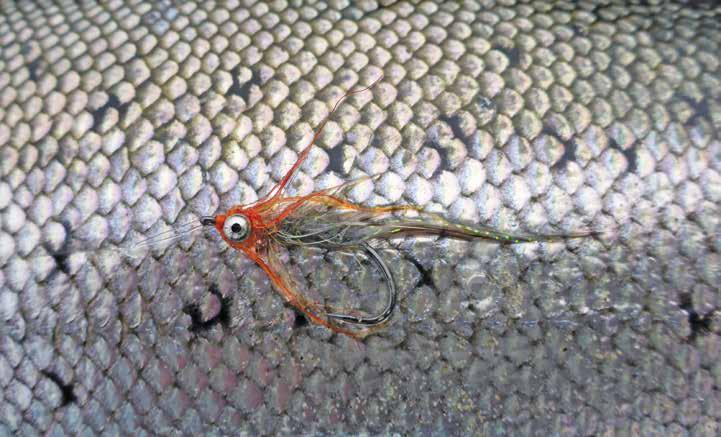



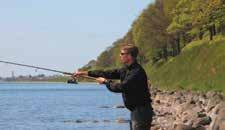
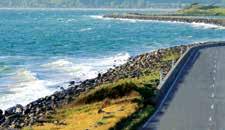
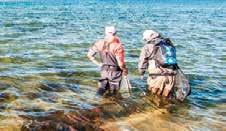
6 FYNS LAKSEFISK
A modern facility for fish and the young people who are interested in them...
9 FISHING GUIDE BOOK
117 Fine Funen Fishing Spots: Fyn, Ærø and Langeland offer kilometre upon kilometre...
10 SEA TROUT - IN PRACTICE
One fly, for everything!
17 A TEENAGE LIFE, SPENT FISHING
Let’s forget about sweat, tears and blistered fingers for a moment and instead read some...
24
EVERYONE IS IN THE SAME BOAT
There are plenty of good reasons to support the work of the local amateur...
31 FISHING STORES
A free copy of this magazine is available at these fishing stores in Fyn...
16 ACCOMMODATIONS
If you intend to hunt Fyn’s sea trout over several days, there is good news for you...
23
The new Project Manager at Havørred Fyn: I was born and raised in Odense, where...
30
If you want a guide on your fishing trip, we’ve made this page, with information...
32 FROM HELNÆS…TO Å
The story of Denmark Fishing Lodge, founded in 2013 continues…
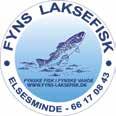

With an annual production of almost 700,000 sea trout for release, Fyns Laksefisk is the largest fish farm in Denmark. Fyns Laksefisk is not just a facility for fish, however. It is also a facility for young people who are discovering their future career path.

The team at Fyns Laksefisk has been farming sea trout for many years. Approx. 365,000 sea trout smolts are released annually into Fyn’s streams through the Seatrout Fyn Project, which is financed by Funen’s municipalities. Around the month of April, the fish are released into approx. 25 different streams all over Fyn, Langeland, Ærø and Tåsinge. After a few days, they swim out to sea, where there is good food to eat. Over the course of 1-2 years, they achieve the minimum size of 40 cm. Year after year, Fyn’s sea trout swim back up the freshwater streams to spawn. The spawning season (typically in November) is when the staff of Fyns Laksefisk head out to Fyn’s streams to electrofish “mother” fish (both male and female sea trout). Electrofishing makes it possible to catch many sizes of sea trout in the streams. They are briefly anaesthetised by the current, caught with a net and then gently transported in a tub of water and oxygen to Fyns Laksefisk in Odense. Once at the plant, they are kept separate, based on three regions of origin: East Fyn, West Fyn and Odense Fjord, depending on the location of the stream’s
estuary on Fyn's coast. The fish are kept in a separate facility, where the temperature of the water is adjusted according to the temperature in the wild. When the fish are ready, they are anaesthetised and harvested for eggs and semen, respectively. Once eggs and semen have been harvested and the fish are awake again, they are returned as soon as possible to the same region they were electrofished.
Eggs and sperm from the mother fish are mixed together and produce new baby sea trout. The fish spend the first stages of their life cycle in the modern farming facilities at Fyns Laksefisk, until they are released back to streams at about 1.5 years of age. This allows many new sea trout to be produced to supplement nature's wild sea trout.
Fyns Laksefisk is a modern fish farm that is based on sustainable principles. All water used by the plant is purified, recirculated and recycled. This system is called RAS (recirculation aqua system). The water is purified both mechanically via a drum filter and biologically in so-called biofilters,
"I think it is important to work in a field that has a sense of purpose. I’ve always been very interested in nature and wildlife, and especially in marine life..."
using the same technique as is used in an ordinary purification plant. Fyns Laksefisk is comprised of several separate facilities, each with its own filter unit. The filters are rinsed regularly, and water quality is analysed to ensure that the fish always have the most optimal conditions.
The recirculation system delivers maximum utilisation of the plant's water consumption. It also makes it easier to control temperature, oxygen content, feed quantities and water composition, etc. while not harming the environment. Both sustainable and forward-looking, Fyns Laksefisk also regularly shows its installation to international industry professionals.
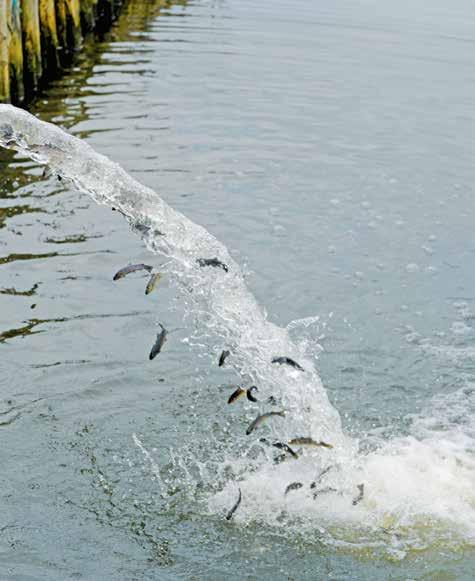
Fyns Laksefisk is part of FGU Fyn (Preparatory Basic Education), which is a school
for young people aged 16 - 25 years who need help to move forward in life with work or education. Fyns Laksefisk is also a place of education for young people working in aquaculture. The aquaculture training course alternates between internships and school classes and takes approx. 3.5 years. Malthe Jensen started as an FGU student but quickly became interested in aquaculture and the work of Fyns Laksefisk, where he is now apprenticed for the duration of his aquaculture training course. Malthe had this to say:
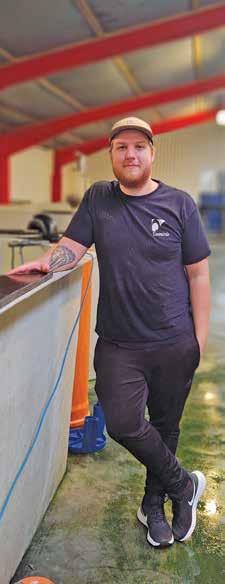
F“I think it is important to work in a field that has a sense of purpose. I’ve always been very interested in nature and wildlife, and especially in marine life. The entire production at Fyns Laksefisk is a process that very much has a sense of purpose. I like the fact that I am involved all the way from start to finish; from electrofishing and catching the mother fish, to
egg harvesting and fertilisation and then rearing the baby fish until their final release. It's also great that no two days are the same. There is a good balance between what I learn when I’m at school and what I learn on site at Fyns Laksefisk. At school we learn the basics of fish biology, water chemistry and how the filters work. But we also learn about new technology, international research, and new ways to breed fish. There are always a few ideas that are worth bringing back. At the same time, I think it makes good sense that I can use what I do at work to better understand the things I learn in school.
I can definitely see myself continuing my career in aquaculture. Who knows? Maybe one day I will start my own fish farm. I am also considering continuing my studies, perhaps in marine biology. There are a lot of possibilities.”
Fyn, Ærø and Langeland offer kilometre upon kilometre of coast just made for sea trout and sea trout anglers.
More than 1,100 kilometres of coastline await, with scarcely a single metre where, at some point, a sea trout cannot be caught. But where do you start? Which are the best fishing spots for different seasons? And what about the wind and the current? How do they affect various locations?
Answers to these and many other questions can be found in our guide book to guide you to 117 brilliant fishing spots around Fyn, Langeland and Ærø. Several of the islands’ most experienced saltwater anglers have contributed to the book and share the benefit of their fishing experience. The guide book is full of inspiration for the seasoned trout angler and the novice alike. Good maps and accurate descriptions make it easy to find just the right fishing spot – depending on the season, fishing method and wind direction.
» 117 coastal spots on Fyn, Langeland, Ærø and the numerous smaller sea trout isles.
» Aerial photos of every single fishing spot bring a brand-new dimension to fishing.
» 15 detailed maps with depth contours.
» The best season and wind direction for each fishing spot.
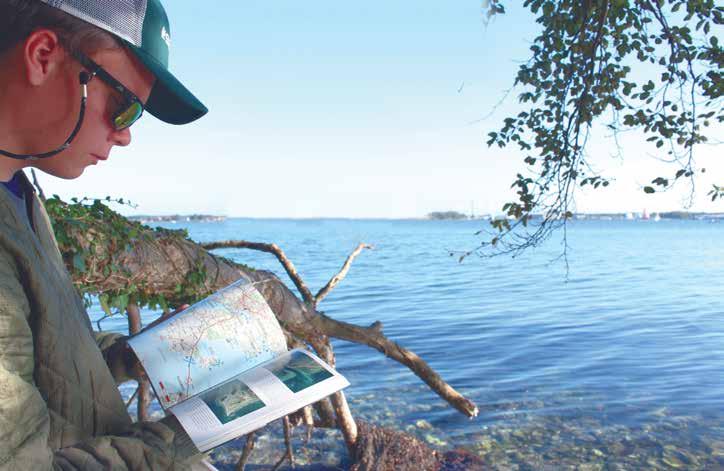
» Useful tips about tackle, strategy and how to fish all year round.
» Useful knowledge about the sea trout.

» Guide to sandbars, reefs, troughs and other coastal features.
» 10 fascinating tales from some of the spots described in the book.
"Buy the book from your local Fyn fishing tackle store"
Tying flies to catch sea trout can be considered science - but it doesn’t have to be.
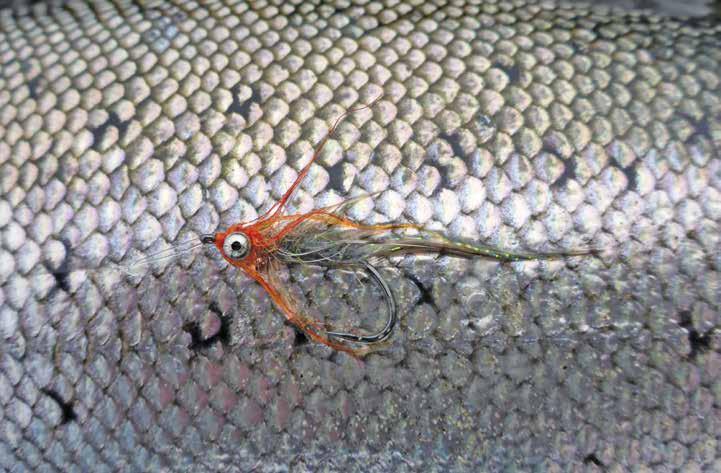 By Johannes Radtke
By Johannes Radtke
If we are to discuss the binding materials that are required and the countless stories where using a particular fly has determined the outcome, then we are really in danger of losing heart? There is just one momentous circumstance that counts: The objective of all our endeavours is swimming these violent waters for just one single reason: The trout wants to grow quickly! If size did not matter to trout, they would just stay in the streams where they were spawned. The Baltic Sea has a heaving buffet on which sea trout can dine, so they often go crazy in shallow water.
Fishing on the coast can be a little more optimistic when bearing this one in mind. If there are fish nearby that are looking for food, you can be pretty certain that they will notice your fly and show an interest in it When fish are ravenous and hunting for prey, even the worst sea trout flies (and yes... such a thing does exist!) can get a reaction and a bite. But with this fly which is a little more optimised and adapted to purpose you will get more bites and hook more fish to bring to land.
Unfortunately, even trout that are trying to build up their fat deposits are not hungry all of the time. There are be days when fish can be very difficult to entice. There have been situations where I have had over a hundred sea trout right below my feet and have been able to lead an excellent fly with almost no interest from the fish. When using a fly that is adapted to the situation, even the most fussy of fish can be tempted to bite. As a matter of fact, on difficult days like that I have had some epic moments that were the result of experimentation with fly patterns and leading
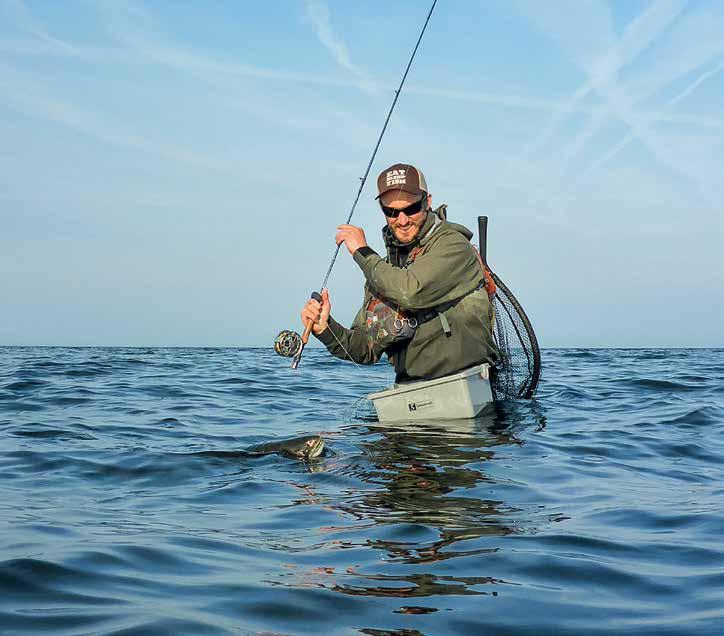
"You don’t need lots of materials and they don’t need to be fancy. The colour choice is up to you."
techniques.
There’s hardly anything that’s more fun or more satisfying that finally getting to outsmart some uncooperative fish.
Using a very good fly pattern allows you to approach your fishing in different moods. However, you can’t avoid varying hook size, type of and, especially, the colour of the materials used.
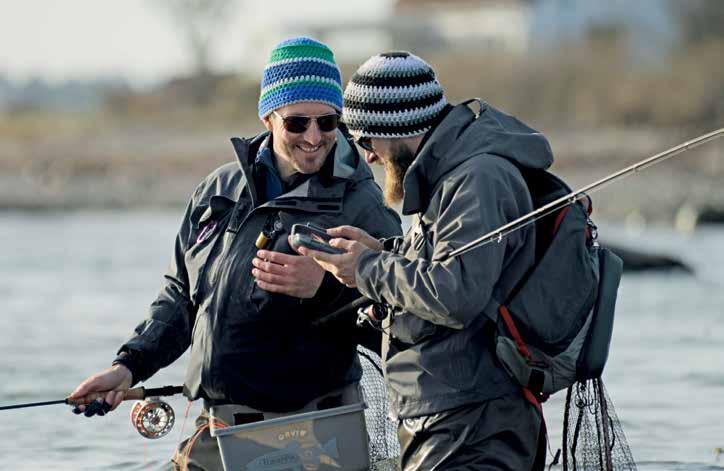
The question of hook size (and thus fly size) is the easiest one to answer: As an intermediate model, a 6 hook makes a good choice. Most of the trout's prey are between 3 and 8 cm, and corresponding flies can be easily tied to a hook of that size. I sometimes use a 4 hook, but more often an 8. My 10s are used only rarely.
Small flies of that type I tend only to use when it is hard to get a bite in waters below 3 degrees.
The quantity of material and accordingly the volume of the fly should be adapted to the behaviour of the fish. It would be easy to write a complete article about this, but here we only be establishing that the more
inactive the fish is, the clearer the water, the more eye-catching the fly, the smaller the material.
The eye-catching nature of the fly brings us to the real question of faith; what is the right colour? Personally, I am a firmly of the conviction that colour is important when fishing for sea trout. Essentially, I am convinced that trout are more willing to be tempted by natural colour patterns than unnatural-looking hues. This is a rule and there are of course exceptions. During the autumn, fish become restless and aggressive because the spawning migration is drawing near. During this period, large brightly coloured flies sometimes produce a better catch. For the rest of the year, the hungrier, more aggressive and thus uncritical the fish, the more enticing an eye-catching fly will appear. Especially in the spring as temperatures are rising and trout tummies are rumbling at a time when food is scarce, then the “loudest” of flies (like the pattegris) will almost always produce a great catch. Thanks to their stark colours they will be able to tempt fish from far away.
Even at this time of year, however, big eye-catching flies have their limitations. When you find a school using a tempting large fly (which is not uncommon during the spring) there will normally be contact from your first cast.
But even ravenous trout are not stupid; they can see that the giant, glittering, pink "shrimps" in the shoal QUICK TIP are stressing the other fish and causing them to take evasive action. Already after the next couple of casts into the shoal, bites will be cautious or the fish will only follow the fly up to a point where they stop reacting. Here, simply changing to a small discrete fly can work miracles. Personal preferences are the most important factor when choosing colours. Each individual fisherman has their own favourite colours and may not even like other colours. Here I have presented my favourites. Considering all the hysteria about colours and UV, bear in mind that sea trout are a predator whose primary motivation is to catch prey.
This presupposes determination and a cer-
tain amount of hunger and does not harmonise with the notion that there is one “right” colour.
The same also applies to the pattern. The fly shown here is ultimately just a modified Woolly debugger – a simple streamer with a few distinct traits. Its most important features are a stiffened tail towards the tailing and heavy eyes to make it jig. Personally, I love the Polar Chenille with binding round its “eyes”. It softens the clear contours of the fly and moves enticingly as it sinks. It also allows the use of fine colour effects without having to go to lots of trouble.
WHEN ASKED HOW MUCH MATERIAL TO USE, MY CONCLUSIONS GIVE JUST ONE ANSWER. THIN ONES GIVE THE BEST CATCH RATE.
VERY VOLUMINOUS FLIES GET PLENTY OF ATTENTION, BUT ON MOST DAYS THEY PRODUCE FEWER, LESS ENTHUSIASTIC BITES. WHEN WATER IS TURBULENT OR CLOUDY, OR WHERE FISH ARE VERY AGGRESSIVE, A “MATERIALS BOMB” CAN OUTPERFORM MORE MODEST VARIANTS.
Since tying this fly in this colour combination for the first time it has been outstanding under the most diverse conditions. If I need a fly I can trust because I am not sure there is even any fish to catch, this colour is the one I use for the precatch, especially if the weather is overcast and the water is somewhat cloudy. I also use it on sunny spring days.
Heavy lead eyes (made by Wapsi) mean that this fly “dances” up and down a lot. Its long tail, slim profile and dark eyes give the fly a very "fishy" appearance when it is “led” quickly. Coastal sand eels will also accept this variant.
This very striking colour combination is intended for cold water fishing, when fish are unable to find enough food and are very hungry.

It will catch the same fish as those you can catch using the famous “pattegris” fly. It is also effective during the autumn. Coloured, aggressive small males will bite hard.
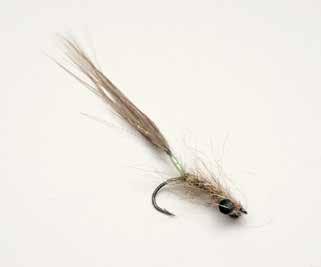

This colour became a permanent fixture in my fly box a few years ago. When it’s in the water, this fly looks to delicious to not eat; not just for the trout. I even think so too!
I’ve caught fish with it in sunshine, pouring rain and even in very cloudy water. Even with the first cast you almost always get a result...
Ilike to rely on this little fly if the fish are really difficult or I have found a whole school of them.
On an 8 or 10 hook, this colour combination almost resembles shrimp or amphipod larvae, so inactive fish will gobble it up too. The fly can therefore be fished correspondingly slowly.
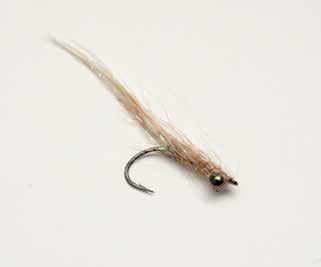

High waves, murky waters and fast-swimming fish are the right conditions for this fly.

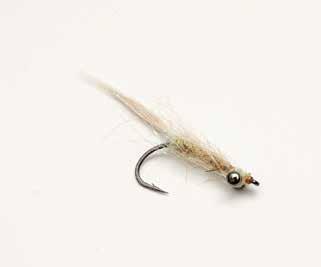
Unlike the other flies shown here, I tie this one with a little more volume. Under the conditions described this is usually more beneficial than detrimental. Its dark brown colour is very eye-catching in cloudy water. Only black is more eye-catching and is also a good variant.
uring the autumn, winter and spring I like to use stark colours.
If the “hey look at me!” fly is too much, e.g. when it is sunny, I like to put my trust in a grey variant with a red polar chenille collar. The tail can also be a lot shorter than on the one shown here. When tied to an 8 hook, this fly is good when “led” slowly.
Here’s how: Tying an effective Sea trout fly

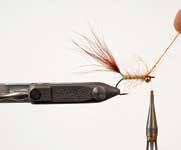

WHAT YOU NEED:
Hook: Gamakatsu F314 size 4-8
Thread: 6/0 – 12/0
Load: Dumbbell eyes, e.g from Wapsi
You don't need a lot of unnecessary material. The choice of color is a personal decision.Tip for tail support: Saltwater Flashabou is almost a cheaper Flat Pearl Tinsel.
Tail: Marabou
Tail support: Flat Pearl Tinsel (wide) or similar
Paint: UV-active paint
Body: Dubbing, e.g. SLF Saltwater Dubbing
Body shackle: Neck or saddle feathers with short, soft fibres
Tie wire: 0,20 mono
Head: Polar Chenille, for example from Flies & more
Wind the eyes tightly just behind the hook eyelet. Tightly wind the tail up to where the hook starts to bend Wind the Pearl Tinsel tightly round the marabou tail (with caution, as this can be tricky).
Split the hackle feather and wind it together with the winding cord. Work the dubbing into a loop and brush it up.
Wind the cord around the eyes and then back, winding tightly. Wind in the Polar Chenille, cross-winding round the eyes.
3 5 7
Put a drop of paint on the tail support. This will allow the fragile tinsel to withstand a lot of bites.
Here, we use a UV-active paint as an extra enticement.
Fold the body behind the eye. Bring the hackle forward with 3-4 turns and secure it in position.


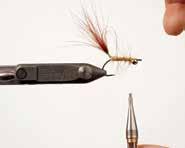

Secure the Polar Chenille, tie 3-4 master knots and apply a little paint. Scrape the material a little with a dubbing brush or an old toothbrush. And the job is done!
1 4 6 15
If you intend to hunt fyn’s sea trout over several days, there is good news for you and your fishing buddy: stay in an authentic angler’s cottage and get more fishing time by the water.

Along the coasts of Fyn, ÆRØ and Langeland there are close to 30 certified accommodation establishments, all making us anglers, in particular, very welcome. That means they are aware of the things that matter to us.
The accommodation establishments have local knowledge of the fishing; they can assist with procuring certified sea trout guides, fishing licences, you can dry and store your gear and even hire fishing boats and kayaks – and much more besides!
ALL THESE ESTABLISHMENTS CAN BE FOUND VIA WWW.SEATROUT.DK
AND YOU WILL RECOGNISE THEM BY THIS SIGN: HAVØRRED FYN PARTNER.

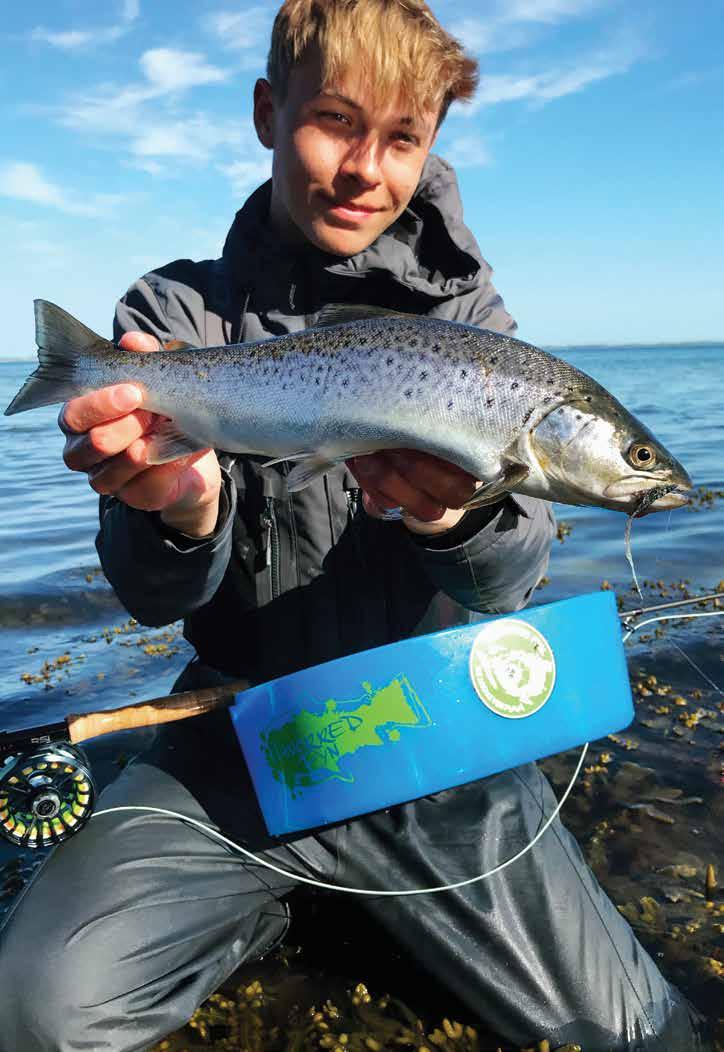
Let’s forget about sweat, tears and blistered fingers for a moment and instead read some stories about why fishing for sea trout on Funen is so fantastic and addictive. Read about Sven’s teenage passion and find some great tips here.
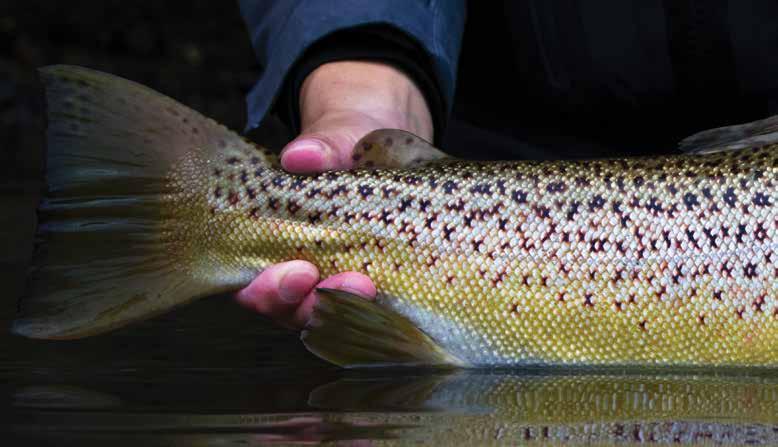
My name is Sven and I’m a trout fishing enthusiast. Anybody who knows me is well aware that I spend every hour I can on the coastline. Preferably holding a fly rod, but I do like to spin every now and then.
I live in in the southern part of the island of Funen and I know the coastline and fjords of this part of Denmark inside out; perhaps because I am always on the lookout for new fishing spots on Google Maps. Another reason might be that I spend hours and hours going up and down the coast looking for shiny sea trout.
Like many others, my gateway into fishing began with a spin rod. As time went by, I gradually became more and more interested in fly fishing. Fly fishing is almost silent and is the perfect way to “stealth
fish” and I absolutely love it. I am in no way dogmatic that this is the only way to fish, however. I still like to get out my spin rod if the wind is too hard or the conditions are better suited to long casts with heavy weights. Success comes first!
I tie my own flies when catching fish. The advantage of doing this is that you can always have flies at the ready that resemble those eaten by sea trout in the various seasons. It’s also extremely satisfying to catch a sea trout on a fly that you tied yourself. The diet of a sea trout comes from a large number of different prey. Some of them are only available at certain times, while others are around all year. This is why I always take a good look at the shore be-
fore wading out. Sometimes I drag my net through seaweed to see what life is present in the water. Doing so allows you to see, for example, what colour prey such as shrimp are, as this will vary by season and fishing spot. When I notice a prey creature in a new or different colour shade, I’ll tie a fly to imitate it, using the same colours and being as realistic as possible. This is not just to grab the interest of the fish but is also a matter of personal pride.
Some of the prey appears several times over the course of a year, but at different times. These include various small creatures like nereididae (ragworms), mysis and northern sand lance. When these creatures are thriving best and when there are most of them, they are also typically prey that are hunted and eaten by sea trout, so it pays to
keep an eye out for them when they start appearing at the water's edge. One thing I always look forward to and keep an eye on is when ragworms emerge and begin to swarm. This is always a sign that spring is here and it is time for spring fishing. This is when big, shiny sea trout head towards the massive ragworm banquet that will make them grow big and fat. At this time, I'm ready with new, home-tied ragworm flies that I use from mid-winter to early spring. This method is called “matching the hatch” and it applies to many of the sea trout's prey.
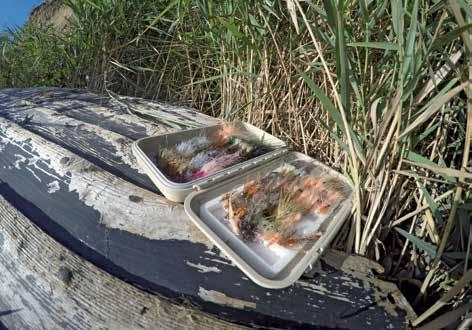
At deep, high current locations, I have frequently seen fish eating food at the surface
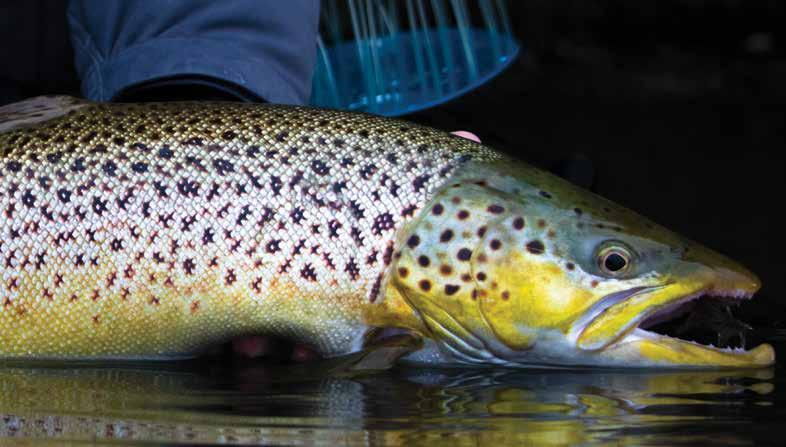
"Like many others, my gateway into fishing began with a spin rod. As time went by, I gradually became more and more interested in fly fishing"
yet unwilling to bite when fishing with blinks or large full-bodied flies. On several evenings, I observed which insects they were interested in. Sometimes it would be large moths and other times it would be very small mosquitoes and flies. Based on that observation, I tie foam beetles and dry flies to resemble the small animals I can see the sea trout have shown interest in.
During the summer, I fish in places with
deep underwater slopes and plenty of current because fish are often right on the edge of the slope or the edge of the current. On windless summer evenings, you will often see the fish on the surface, trying to catch the swarms I talked about before. I often stay on land with the line following its own curve – ready to cast while I wait for a fish to appear. When I see a fish, I move ever so quietly into the water and
gently cast to the fish with my newly-tied fly. Choosing the right dry fly or foam beetle and giving just the right amount of cast at just the right time is one of the most exciting and fun things about coastal fishing in my opinion.
The same goes for autumn fishing, but here, I fish typically in the fjords or the small “mud holes”; shallow areas with soft bottoms. I enjoy fishing in places with soft
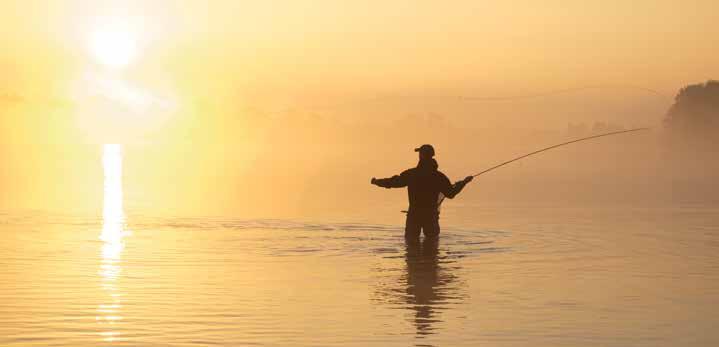
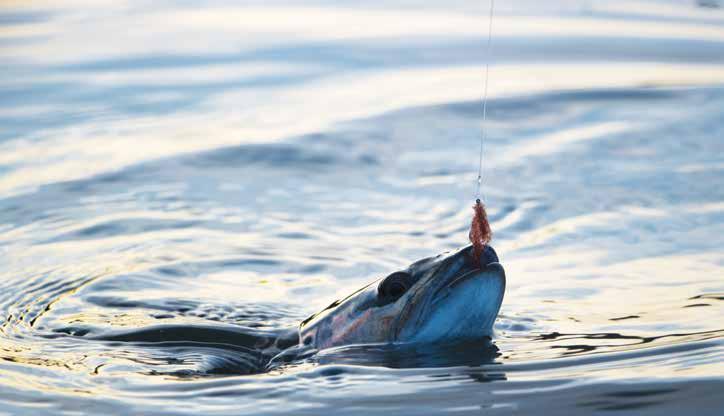
bottoms, dense seaweed and forest nearby, preferably with a strong wind at my back. If you find such a place in the autumn, insects will sometimes blow into the water and, oddly enough, sea trout absolutely love it. That’s why, in my opinion, it’s always smart to have a foam beetle or two in your tackle box when fishing in the autumn.

Surface fishing where sea trout appear as rings in the water, or where their dorsal tail fins break the surface, is intense and is often about the precision of your cast. This can be difficult with a spin rod. Precision is less of a problem than the fact that the bait you cast will often disturb the surface so much that it will scare the fish. Therefore, I fish with a fly when trying to catch fish that appear on the surface. This is socalled “sight fishing”. Here, we are still in small shallow fjords and muddy holes, fishing with similar flies. But in this scenario, where fish are “on the fin” and active on the surface, I prefer level water. This makes it easy to spot the fish and cast to them.
I tie small weightless flea flies and fish them with a floating line so they float in the water when I stop reeling back.
Feet firmly planted at the water's edge, I’ll wait to see if a sea trout should appear at the surface within casting length. The line is pre-pulled by the wheel and ready to float away in an instant. Often, you only have a few seconds before the rings from the movement of the sea trout are gone again. Depending on the size of the fly, I try to drop it in a metre or two ahead of the fish. If you let it sink, with a few careful short tugs on the line, you often get the desired reaction; a bite! This takes patience and concentration.
Catch and release is a very important part of my fishing hobby and the way I fish. Thin, coloured fish that have done, or are on their way to do “their duty” and breed in the river should, in my opinion, always be put back.
While spawned winter and spring fish can be found both in the fjords and on the open coast, autumn fish are most frequently found in the fjords. I fish for (and typically catch) autumn sea trout on realistic flies, making very long stops and letting

the fly float in the water. Flea flies such as the classic copper bass are often very successful in this type of fishing. If I have a spin rod with me, I always fish during this period with small light blinks that can be fished ultra-slowly and that will rotate when making a spinning stop. This is SO effective. I am always cautious in the way I handle fish before release. They are only ever out of the water for a few seconds, just long enough for me to snap a photographic "trophy" of my proud catch. Take
good care of hard-working spawning or spawned sea trout so that they can also be caught when in peak form!
Break a leg out there on the shores of Funen.
Sven Riber Hougaard, amateur fishing enthusiast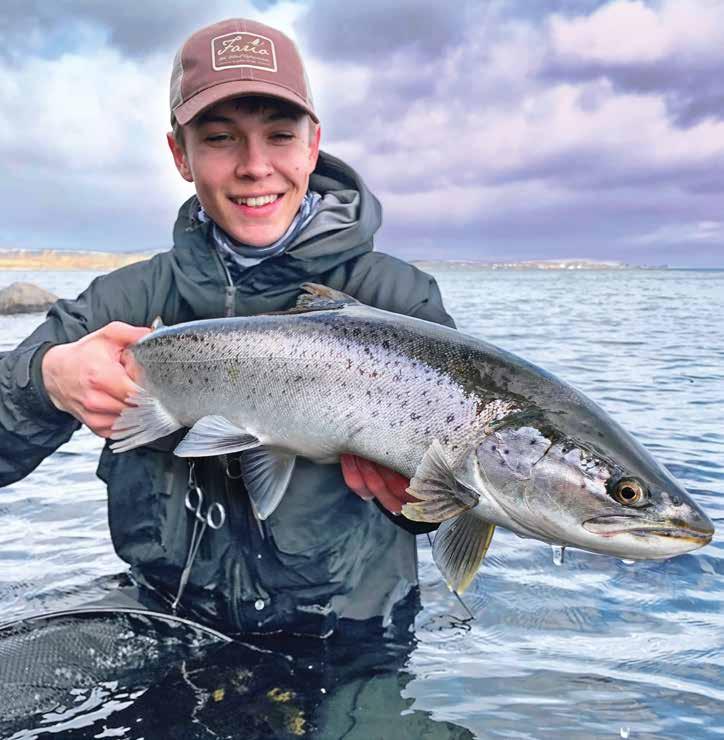
Iwas born and raised in Odense, where my uncle took me on my first fishing trips. I was given my first fishing rod on my seventh birthday and one and a half years later I caught my first river trout in Odense river near Skovsøen lake. I quickly developed a love of nature and of angling and seized every opportunity to get out there.
As it became possible to travel around Funen on my bicycle, more and more fishing trips became possible. Many of the trips were to Odense river, but I would also go fishing in various lakes and, eventually, on some exciting trips to the coast. Many of those first years on the coast were with limited results, and the sea trout were unwilling to cooperate. As time passed, however, I would eventually be able to catch a lot of sea trout on the coasts of Fyn. Like so many others, I too have enjoyed the benefits of the work of Havørred Fyn and the great local coastal fishing.
My interest in fishing quickly gave me an interest in biology and in river biology in particular. I therefore decided early in my life that I would become a biologist and would work with rivers and streams.

That decision has brought me to where I am now. I finished training as a biologist in 2000 and have since then been working with rivers/streams and watercourse restoration, initially at a practical level with HedeDanmark, and then at administrative level with Bangsgaard & Paludan. Finally, I have 8½ years of municipal experience from Kerteminde municipality, where I worked with watercourses and was part of Havørred Fyn’s rivers and streams group. My time in Kerteminde also meant going on lots of great fishing trips, where I would enjoy fishing on Fyn’s coasts with my colleagues. When the opportunity came to work with the Havørred Fyn project as the new project manager, I thought it sounded like an exciting and challenging task. I will therefore be based in Assens from now on, working not only with the Havørred Fyn project, but also on other rivers and streams related projects, in which I continue to be very interested. I hope that my work will help my children and future generations to also be able to enjoy catching beautiful shiny sea trout on the coasts of Fyn.

HAPPY FISHING OUT ON THERE ON THE COASTS OF FYN!
There are plenty of good reasons to support the work of the local amateur fishing associations and Danmark’s Sportsfiskerforbund (the Danish Sports Fishing Association). This is also true, even if you only ever fish for trout along the coastline of Funen. Read the following to find out why.
“Oh come on.... Why do I have to chip in? I paid for my fishing permit after all!” These are typical answers you might expect to hear when asking trout fishermen on the coast whether they are members of an amateur fishing association or the Danish Sports Fishing Association. The fact is that out of approximately 160,000 fishing permit holders, a mere 19,000 are members of an association affiliated with the Danish Sports Fishing Association. It is worth noting that this limited degree of organisation is not typically a Danish phenomenon. It also seems to be the same story in all the countries to which Denmark normally compares itself. This is a pity, because unity and support for the task of making amateur fishing even better ought to be in everyone's interest.
Amateur fishermen (at least until the corona crisis showed us that we are all in the same boat) are largely individualists. One of the premises of amateur fishing is that your chances of making a catch are significantly increased if you are the first person to cast the line into the fishing waters. This might be one of the reasons why it can be difficult to unite a larger proportion of amateur fishermen into a committed community. Many of them also have strong attitudes, plenty of expertise and an admirable commitment to nature, the en-
vironment and fisheries management, and if their attitudes are not an exact match with the framework provided by associations and the Danish Sports Fishing Association, many will choose to stay on the outside, using social media as a means of gaining influence instead.

Once again, however, we should point out that it is a shame that the lone wolves are not instead choosing to support those who can actually make a difference. And, after all, all amateur fishermen regardless of the species they catch or their preferred subbranch of fishing they engage in, agree on the ultimate goal: that fishing must be as good and as accessible as possible. Disagreement is therefore more about how to get to the end goal, than about the actual end goal itself.
It could also be the case that the low willingness to join is simply because many enthusiasts think that it is the task of the authorities or the state fishing permit agency to ensure that there are fish to catch. Some people even leave it to chance. And to be fair, without state fishing permits and support from the authorities (and here on Funen, Havørred Fyn (“Sea Trout Funen”) plays a very important role) the situation would be very much worse. HOWEVER,

without the decades-long voluntary efforts made by large numbers of enthusiasts from the various associations in combination with the fight of the Danish Sports Fishing Association for better environmental and fishing legislation, which is actually being complied with, present day amateur fishing in Denmark would not be worth writing about.
So what contributions are being made by the many enthusiasts from the various associations and have made such a massive difference? These can be divided into three focus areas:
» Fish care – here defined as electrofishing for mother fish, breeding work, releasing fish of various sizes, studies of trout density in streams, management of cormorant and seal populations, monitoring illegal fishing and participation in meetings, courses etc., where the theme is fish husbandry.
» Water management – here defined as all kinds of initiatives that protect against deterioration or improve the aquatic environment in rivers and streams. These may include the establishment and restoration of spawning
grounds, the laying of stones and dead wood for concealment, the removal of barriers, the establishment of watering places for cattle, the maintenance of watercourses, counting spawning trenches etc., planning restoration projects, contact and dialogue with authorities and landowners, participation in and hosting of courses, participation in meetings of Vandråd (the Danish Water Council), Grønne Råd (the Danish Green Council), the Danish Sports Fishing Association and meetings in other green networks.

» Work towards improving fishing waters – i.e. which are all types of initiatives that improve access to fishing and which can help to provide a better overall experience at fishing spots. Examples of such initiatives include: maintenance of paths, fishing jetties, footbridges, boats, shelters and fishing cabins, establishment of parking spaces, emptying of rubbish bins at car parks, trimming the grass at parking spaces, pruning of trees and shrubs at fishing spots, waste collection, setting up
ble bench sets, information signs etc.
The associations have provided these efforts free of charge for many decades, and in recent years their work on water husbandry in particular has been intensified. The great progress we have seen in sea trout stocks since the 1980s (during this time these have increased fourfold and perhaps fivefold nationwide) can largely be attributed to the efforts of amateur fishermen. With some exceptions, it is only in the last ten years that the authorities have really begun to take the task of improving watercourses seriously.
The contribution made by amateur fishermen received official recognition when then Minister Eva Kjer Hansen awarded DKK one million in funding for voluntary initiatives in connection with the implementation of Denmark’s amateur fishing strategy in 2018. Had she known how many hours our volunteers spend restoring
a good fishing environment, she would probably have awarded them a far greater sum by way of thanks for many years of faithful service. But we admit she had a good excuse, as this was not investigated until last year.
In 2019, the Danish Sports Fishing Association examined the extent of the voluntary work that was being done on an annual basis by member associations, and an estimate was made of the value of these efforts. It turned out that the associations spend a total of just over 60,000 hours a
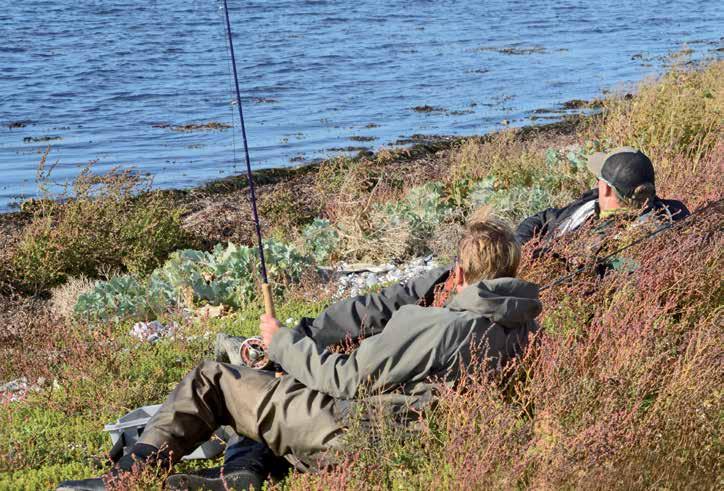
year on the various initiatives. These hours are distributed such that they spend about 9,000 hours working on fishing water, about 27,000 hours on fish care and 24,000 hours on water care. In addition to the many hours, the associations also spend almost DKK two million on these tasks each year, from their own pockets.
How great is the value of the efforts made by volunteers? By using the 2018 Danish average salary according to Statistics Denmark, we were able to calculate that this work has a financial value of almost
DKK 15 million. When the two million from the associations is added, this makes a total of almost DKK 17 million. Is that a little or a lot? The state finances approximately DKK 25 million annually towards improving watercourses, so that the efforts of volunteers correspond to almost 70% of that amount. And that’s quite an achievement, isn’t it?
There are therefore many good reasons to join an amateur fishing association and support their work towards better fishing and become part of a community that is
"It makes particularly good sense to do so on Funen, which is home to Den Fynske Grusbande (the Gravel Gang of Funen), who has achieved good successes in restoring trout streams which help to improve sea trout fishing along the coastline."
both valuable and creates value. It makes particularly good sense to do so on Funen, which is home to Den Fynske Grusbande (the Gravel Gang of Funen), who has achieved good successes in restoring trout streams which help to improve sea trout fishing along the coastline. So we are passing on their invitation to contact Vandpleje Fyn (Water Care Funen). They also need YOUR efforts!
The volunteers have their hands “in the water” and gravel from spawning grounds “on their shovels”, and their magnificent efforts can often be seen soon afterwards in the form of increased numbers of trout in the streams. This is in contrast to the way the Danish Sports Fishing Association works. The association works more on the level of policy and often with longer time perspectives. The nine employees at the secretariat in Vingsted near the river in Vejle work with many different tasks, but the focal point is work to support the associations in ensuring continued progress for amateur fishing. This is no easy matter in a country where two thirds of ground area are cultivated, where 95% of watercourses are regulated, and where the extent of oxygen depletion in inland waters is at a historically high level. The fight for better management of nature and natural foundations IS and always has been the cornerstone of the association's work.

Many amateur fishermen are not interested in politics generally, and this may be a third reason for the low degree of organisation among Danish amateur fishermen. Oddly enough, however, most amateur fishermen do actually have opinions about mussel scraping, the straightening and excavation of streams and to intensive net fishing in local fjords where they fish for sea trout. This shows that it may be more a matter of communicating political messages to make them more relevant to larger numbers of amateur fishermen. This realisation has led to communication in the Danish Sports Fishing Association being
given higher priority than it is right now, currently being active on many platforms and with a well-visited and relatively new website, www.sportsfiskeren.dk.
On the website, you can read about amateur fishing and catches but also about the association’s work towards influencing policy. And even though the Danish Sports Fishing Association is a small organisation, it has actually succeeded in impacting important political decisions over the past decade; decisions that have either safeguarded against the destruction of the natural order or definitely helped to
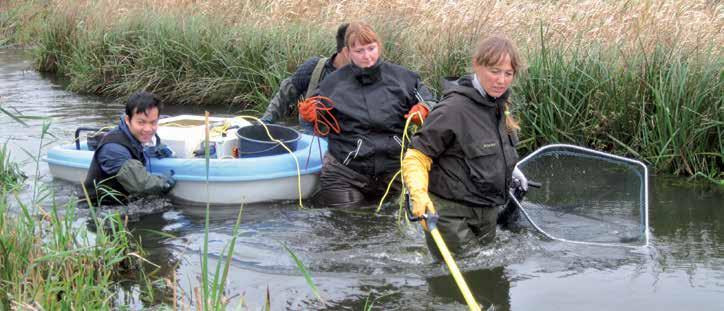
improve it. One noteworthy victory was preventing a proposal that would have allowed aquaculture production in Kattegat. The association's opposition was partly because nutrient salt emissions could have a negative impact on inland waters and partly based on a concern that fish production in waters with higher salt levels north of Funen could potentially lead to a large spread of salmon louse to wild fish populations, as has been seen in Norway, among other places. Here, many trout stocks are hard pressed due to the small parasite, which has a particularly negative impact on smolt.
Another important victory was when, 5-6 years ago, after persistent pressure, it was decided that trout would be used as a measurement parameter in the Danish Water Framework Directive. This directive means that 19,000 km of watercourses must satisfy various formal requirements. Since 2016, one of these was that there should be large numbers of trout in the watercourses. That goal must be met by no later than 2027 and will be seriously felt by sea trout fishermen in both fresh and salt water.
A third important victory (and one on Funen, even) was the 2015 decision to prohibit deliberate net fishing of sea trout in Odense Fjord. The executive order was also made in close collaboration with Vandpleje Fyn (Water Care Funen).
A final important decision, from as recently as spring 2020, was when the Danish
Environment and Food Complaints Board decided that municipalities must also take wildlife into account when maintaining watercourses. This means that municipalities must in future ensure that, for example, aquatic plant management does not destroy the possibility of there being a well-varied composition of aquatic plants, small animals and trout in the watercourses. This clarification will certainly also mean that trout stocks in many streams across the country will be able to increase by large numbers.
Although many amateur fishermen may not be conscious of the fact, we are actually all in the same boat. We all depend upon well-maintained watercourses that are able

to produce plenty of wild sea trout, fjords with no intensive focused net fishing for trout and clean aquatic environment with no parasites and without reduced oxygen levels. If that realisation can make you consider contacting your local association to ask them how YOU can contribute towards good fishing, then it will surely be well received by the enthusiasts who have been doing all the legwork for decades!
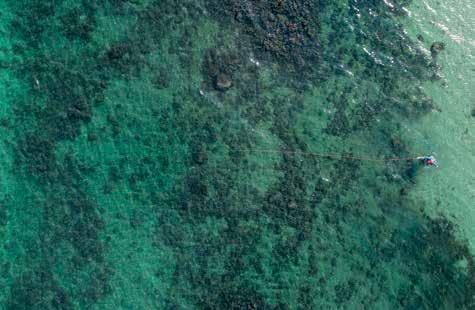
"Although many amateur fishermen may not be conscious of the fact, we are actually all in the same boat."
Turbo-charge your fishing for sea trout: sea trout Fyn is 1,100 km of sea trout coast distributed across 90 islands – and the key to successful fishing is knowing precisely where, when and how to fish.

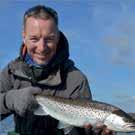

You can meet a professional fishing guide with local, up-to-date knowledge of the coastlines, who will make a world of difference to you and your fishing.


PRICER: 1/2 day (4 hours): DKK 2,000 1/1 day (8 hours): DKK 3,000











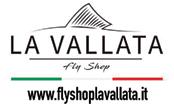

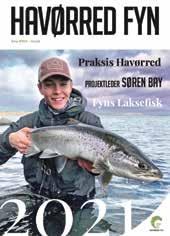

It was back in 2009 when an entrepreneur from the sportfishingworld and his partner formed the idea to create an accommodation 100% dedicated for the sea trout anglers visiting Fyn. Not a traditional one, but a location heavely inspired by the professionalism of some American fishing lodges. After the idea was born, it took them no less than 4 years of efforts and planning. In 2013 they opened a unique
accommodation of its kind in Denmark: Denmark Fishing & Outdoor Lodge. Despite being a relatively small business operation, the Lodge quickly became a very active protagonist. It played a fundamental role in strengthening the popularity of our sea trout fishing destination, especially among anglers abroad. The hard work carried out by the staff have been inclined in promoting the sea trout fishing
in Fyn in general. Their networking and branding have had the secondary effect of increase the popularity of the fishing, which has generated positive side effects for the local community as well.
During its 5 years of operation, national and international medias visited this pioneering Lodge several time and have been writing about it or interviewing its staff. All this attention and curiosity about
" But they have announced a reopening in a new location of the same area in spring 2021!"
this small entrepreneurial initiative, has strengthened focus on sea trout fishing and angling tourism in general.
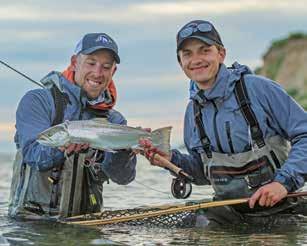

During the period from 2013-2018 the Lodge has been successfully going and was visited by no less than 16 different nationalities of anglers from all over the world (Japan, Israel, USA, New Zealand, just to cite some.). Some guests of these nationalities would probably never have heard of or visited Helnæs or Fyn in their life, if Denmark Fishing & Outdoor Lodge would not have been there in the way it was. In 2018, due to force majeure, the ownership had to close the Lodge. But they have announced a reopening in a new location of the same area in spring 2021!
The Lodge was, as told, founded in 2013. At the beginning many people did not understand the initiative, so the initial phase wasn’t easy.
The chosen location was an existing building on Helnæs, in the south west part of Fyn. Helnæs is a beautiful Peninsula connected to the mainland of Fyn by a long-curved isthmus.
The Lodge did not follow a model but was a rather unique mix of international influences that tried to pay attention to the quality of the fishing services and facilities. Just to give an example the kitchen was mainly based on Italian homemade specialties, turning the place into an “exotic mix” for being in Scandinavia. Not only
fishing tourists, but also some famous personalities have enjoyed a stay or was just visiting this Lodge. “a location that made everyone feel a bit at home.” With the Lodge very well established and fully running the ownership unfortunately had to close in 2018. Due to force majeure, they had to take the decision to stop the activity. The new goal was to take a break and then find a more ideal property, possibly in the same area, in order to restart an improved Lodge 2.0 operation as soon as possible.
A new location in a nicer position was finally found and purchased after a 2-year hard search. This final location is at the
"
The Lodge did not follow a model but was a rather unique mix of international influences..."
border of a village called “Å” only 4 kilometres from the old address. This small piece of countryside holding a nice East side view over the fields and a South side view over the sea, has been chosen to set the foundations of the Lodge 2.0 and to start a new chapter of its story. Not only took it more time than expected, but obviously the unexpected COVID general situation played a negative role in the timing of the Lodge 2.0 creation and opening process.
Å is a conglomeration of a few houses, mainly with a view to the seaside. A countryside where the little creek flows into the sea. A small, but very important water system where sea trout from the whole area runs for spawn and lay eggs. This happens every year, primarily in the fall season. The new grounds are parallel to the flow of this river, giving an extra idyllic or maybe even romantic add to the whole concept. Here romantic is intended as for a fisherman of course!
Å is a beautiful corner of this south-western part of Fyn, only a few hundred meters north-west of the isthmus of Helnæs, with Helnæs as a background view. From Å there are some paths through open fields, which brings you directly to the sea. From Å it is also possible to reach Brunshuse and Helnæs by feet or bike. The view from Å is quite spectacular. From the main sandy beach of Å, called Å strand, it is possible to enjoy an unforgettable orange and purple sunset by looking on the right side, and at the same time it is possible to have a view of the west coast of Helnæs including the lighthouse on the left.
Compared to the old location Lodge 2.0 will be closer to more first-class fishing spots, which is strategically better. And the first ones are easily reachable by feet. The staff designed the plans and draws the Lodge 2.0 themself. Their idea is to create something integrated in the natural landscape. So, the choice was to construct a new building with external facades made with natural unpainted wood. The struc-
ture will have big window frames that allows a nice panoramic view over the fields with the sea as background.
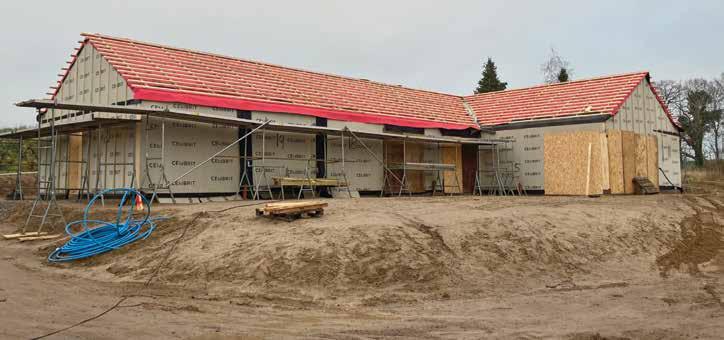
If the 2013 Lodge was a pioneer project, the Lodge 2.0 holds a particularity that makes it unique once again; It will not be a facility obtained from an existing building adapted, but it will be the first facility of all Denmark to be built as an entirely 100% traditional fishing Lodge, solely minded for anglers.
Once back in operation, the Lodge will maintain the same intimate fishing atmosphere as before and will offer the same choice of opportunities ranging from the full service with guiding and meals, and down to booking a room or participate to a fishing course or event.
The reopening must be a motivation to tell even more about our destination. It is important to spread the word of excellent sea trout fishing on Fyn abroad!
In conclusion, apart from a new location with a nicer view, the story of this small inspiring Lodge, founded in 2013 continues…
"Å is a beautiful corner of this south-western part of Fyn, only a few hundred meters northwest of the isthmus of Helnæs..."
We are here to support you in your hunt for sea trout
WE ARE HAPPY TO HELP YOU WITH
» We are happy to help you with an angling license
» Local accommodation for anglers
» Local activities
» An active outdoor holiday
» Attractions (also beyond salty sea trout!)
» Shopping
BOOK IT ALL AT WWW.VISITFYN.DK
YOU WILL FIND US HERE:
VISIT ODENSE
otb@visitodense.com
V
ISIT KERTEMINDE
Strandvejen 6, 5300 Kerteminde
Tel. (+45) 6532 1121
turist@visitkerteminde.dk
www.visitkerteminde.dk
ISIT FAABORG
Torvet 19, 5600 Faaborg
Tel. (+45) 7253 1818
visitfaaborg@fmk.dk www.visitfaaborg.dk
VISIT SVENDBORG
Havnepladsen 2, 5700 Svendborg
Tel. (+45) 6223 6951
turist@svendborg.dk
V
ISIT NYBORG
Torvet 2B, 5800 Nyborg
Tel. (+45) 6333 8090
visitnyborg@nyborg.dk
www.visitnyborg.dk
ISIT NORDFYN
Vestre Havnevej 9B, 5400 Bogense
Tel. (+45) 6481 2044
info@visitnordfyn.dk
www.visitnordfyn.dk
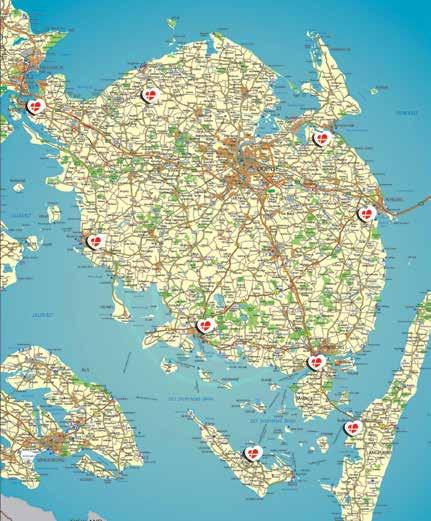
www.visitsvendborg.dk V
ISIT ASSENS
Tobaksgården 7, 5610 Assens
Tel. (+45) 2337 8466
info@visitassens.dk
www.visitassens.dk V
LANGELAND TURISTBUREAU
Torvet 5, 5900 Rudkøbing
Tel. (+45) 6251 3505
info@langeland.dk
www.langeland.dk
VISIT MIDDELFART
www.visit-odense.dk V
Havnegade 6, 5500 Middelfart Tel. (+45) 8832 5959
mail@visitmiddelfart.dk
www.visitmiddelfart.dk
Æ
RØ TURISTKONTOR
Ærøskøbing Havn 4, 5970 Ærø Tel. (+45) 6252 1300
post@arre.dk
www.visitaeroe.dk
